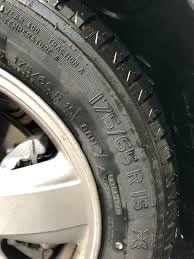Before hitting the road, it is important to check if the car is in good condition to face a trip. Tires are among the items that require more attention, as they are directly linked to the vehicle’s safety.
Connect with a verified mechanic in minutes. No appointments. No high fees. No waiting. Get back on the road and enjoy the ride.
Just look at the side of a tire to see: there are a series of numbers and letters in code format. It is a true “alphabet soup” essential for choosing the right tire for your vehicle. It has information about when the item was manufactured and whether it is time to exchange.
Here we show the meaning of the main codes present in the tires, from the diameter and height measurements to the maximum speed at which you can ride with a certain model. Check out the information, based on the image below:
The Meaning Of The Letters And Numbers Of The Tire

275 – Indicates the tire width in millimeters. In this case, the tire tread is 275 mm wide
30 – The two-digit number indicates the relationship between the tire’s (lateral) sidewall height and its width. That is, the indicated height corresponds to 30% of the width. That is, the tire is 82.5 mm high. According to BF Goodrich, the lower the flank, the greater the grip when cornering, but this also compromises driving comfort. Sports vehicle tires, for example, are like this
ZR – The letters indicate the type of internal construction of the tire. According to Michelin, ZR means that the tire is sporty (Z) and has a radial structure, like most modern models
Connect with a verified mechanic in minutes. No appointments. No high fees. No waiting. Get back on the road and enjoy the ride.
19 – Indicates the tire’s inner diameter, from the tread to the rim – technically called the rim height. The tire in question is 19 inches and must be installed on a wheel with the same diameter
96 – The two digits that appear in the sequence indicate the tire load index. The index, informs BF Goodrich, informs the maximum load that the tire can support inflated with the pressure indicated in the vehicle’s manual. Code 96, in the example above, means that each tire can carry up to 710 kg
Y – The letter engraved after the load index indicates the maximum speed for which the tire was approved to run at maximum load. It goes from A, which points to the lowest speed, to Y, to the highest. The letter Y informs that the tire in question can run at up to 300 km / h – of course, it is necessary to respect the road’s speed limits.
DOT
The DOT code determines the age or date of manufacture of the tire. The acronym stands for Department of Transportation, the North American Department of Transportation, and serves for the approval of the tire in that market.
It is followed by two letters, which designate the manufacturing company, and a four-digit numerical sequence, marked in red in the image above. The first two indicate the week of manufacture and the last two, the year.
Therefore, in the example above, the tire was manufactured in the tenth week of 2012. It is worth mentioning that the date of manufacture is essential to know if the component’s warranty is still in force and if the expiration date has already expired.
Even with the tread in good condition, the tires must be replaced every five years, guide the manufacturers. After that period, the rubber becomes old, the adhesion and handling properties can be compromised.
Max Anthony
Max is a gizmo-savvy guy, who has a tendency to get pulled into the nitty gritty details of technology and cars. He attended UT Austin, where he studied Information Science. He’s married and has three kids, one dog and a GMC truck and a Porsche 911. With a large family, he still finds time to share tips and tricks on cars, trucks and more.
Review engine, brake issues, error codes and more with a Mechanic Online in just minutes.
Ask a Mechanic Live Now

